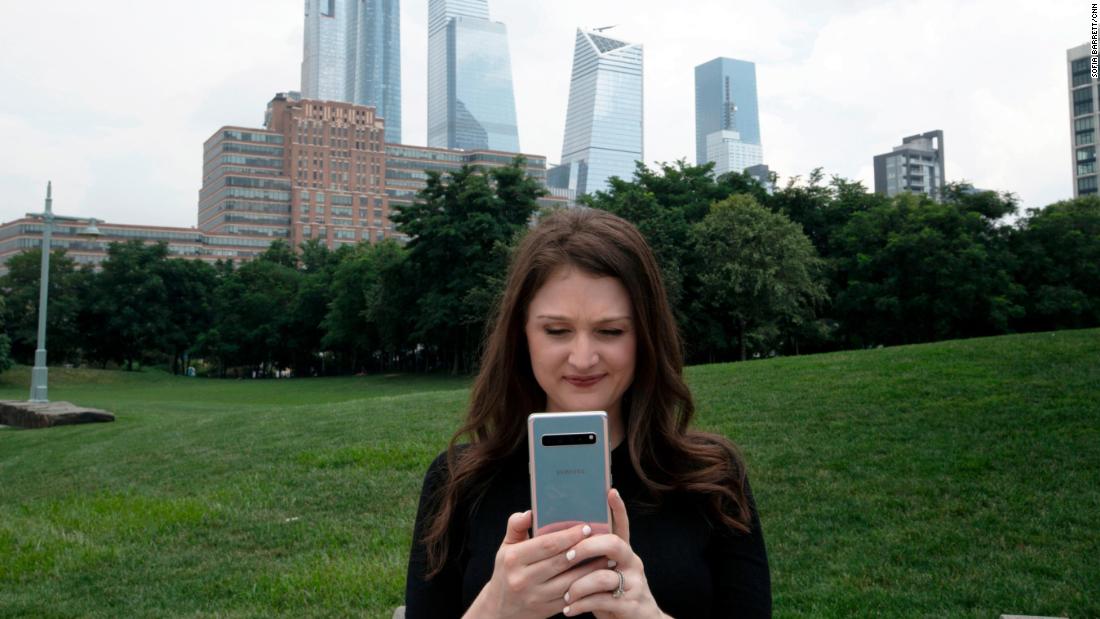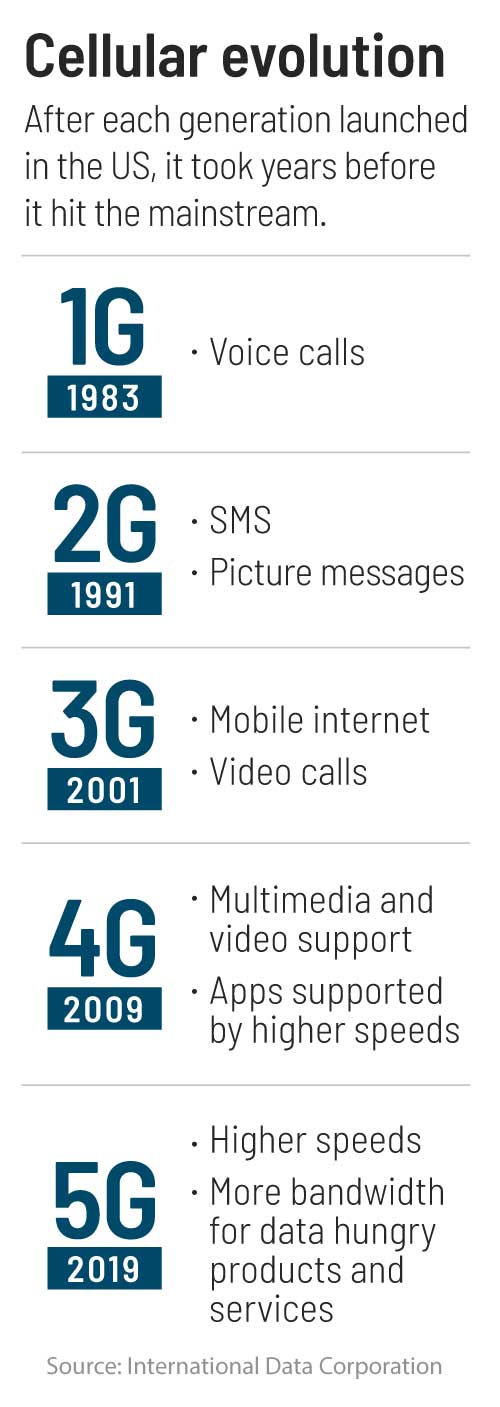[ad_1]
I finally take a few steps back from the lamppost, adorned by a hard-to-miss, clunky black antenna, and bam, my Netflix download begins: a complete download of a two-hour film in less than 10 seconds — in stark contrast to the seven-or-so minutes it’d typically take on 4G.
We’ve maxed out the 4G capabilities of what our phones can do, but 5G could offer a doorway into what’s next. However, carriers have a long way to go before they deliver on that promise.
My 5G network tests, often performed via the Speedtest app, were inconsistent. If I turned a street corner on Verizon, 5G went out of range — a major drawback to the high-frequency spectrum approach being adopted by some carriers. That technology delivers lightning-fast speeds but doesn’t cover wide areas, penetrate indoors and can be blocked by rain or, in my case, leaves.
Inside a Verizon store on Michigan Avenue, I looked out at the cellular radio equipment hanging on another lamppost 20 feet away, unable to get on the network from the other side of the glass window. It poetically captured the current state of 5G: The future was staring right at me but I couldn’t quite access it.
Rollout blues
Verizon was my first experience with 5G: I’ve since tested the networks for Sprint, T-Mobile and AT&T, CNN’s parent company. Each provided a different experience. My speed tests on AT&T dominated, reaching an impressive 1.6 Gbps in a Dallas park and downloading “Spider-Man: Into the Spider-verse” in 5 seconds. (Think of all the movies you could download in the 60 seconds you have on the tarmac before a flight takes off.)
I also tried Sprint, which uses a lower frequency for its 5G network, in Chicago. It was the most consistent in terms of coverage — I was able to duck into a Starbucks, turn street corners and hop into a car without dropping from the network. But its speeds were slower than some of the other networks; I downloaded a movie in about 15 seconds. (This is still mind-blowingly fast.)
“It’s an enormous program involving tens of thousands of people all over the country, and not everyone has the skill set to climb the towers to swap antennas,” he said.
Eventually, many 5G cell sites will need to be closer together in areas previously covered by a single 4G cell. “Not all 4G cell sites are easily upgradable,” Hays said. “Some could be upgradable with as little as a software update while others may need to be replaced completely.”
You have 5G. Now what?
Even in the areas where 5G is already up and running, getting onto the network can be tricky. To start, you’ll need one of the few, pricey, 5G-compatible phones, such as the $1,300 Samsung Galaxy S10 5G or $999 LG V50 5G. (Some testers from the Wall Street Journal and PCMag reportedly overheated when the devices reached a certain temperature. I didn’t have similar issues).
For now, one of the biggest challenges in testing 5G coverage is finding it. I was given a map from Sprint highlighting spots in downtown Chicago where I could pick up 5G. I seamlessly navigated neighborhoods without dropping off the network, envisioning what life will be like when I can download an entire TV season in the few seconds before my coffee order is ready. But without a map on hand in Dallas, I was left guessing which areas would give me 5G Sprint coverage (I was usually wrong).
In Chicago on Verizon, 5G worked well on main avenues but not on the side streets — the equipment hadn’t yet made it over to those blocks. On T-Mobile in New York City, I several times found myself automatically connected to 5G while wandering around different neighborhoods. But other times, I could see the carrier’s cell sites on buildings nearby and still struggled to get onto the network.
Different carriers, different approaches
The four major mobile carriers’ approaches to 5G vary based on the spectrum each company already owns. This is why Verizon can say its network is all about speed, Sprint promises continuity, T-Mobile wants to be nationwide first in 2020 and AT&T is doubling down on connecting businesses.
Wireless companies have traditionally used low-band spectrums for cell phone service because they travel farther and penetrate walls better than higher frequencies. But higher frequencies offer much faster speeds. The frequencies AT&T and Verizon, known as millimeter wave or “mmWave”, are using are significantly higher than Wi-Fi. It is the fastest and most responsive form of 5G but doesn’t travel far.
Beyond phones
“We need to understand what 5G is and how it will enhance our fan experience,” said Matt Messick, chief information officer of the Dallas Cowboys. “We’re one of the first to start asking questions. It’s one thing to start talking about it then to have it and start testing it.”
Messick didn’t elaborate on what exactly to expect, but stadium-goers are competing with a limited pool of bandwidth; the ability to make calls, check the internet for stats and post videos to social media without lag times is as good of an incentive as any to offer fans in the stands.
A ‘dose of reality’
5G is expected to have a major impact on the economy, but exactly how that will look is mostly unknown.
“Right now, job creation is all about the deployment of the network, such as from the tower climbers and equipment technicians,” said Hays, adding it could create a whole new economy just like the internet did.
“Technology development is certainly becoming more feasible, but the question of who will pay also remains,” Hays said.
“[It] did not revolutionize global travel; the jumbo jet did,” Oughton said. “The technology is very fast but only a few wealthy users will be able to afford it at least initially — most of whom will be in urban and suburban areas.” He argued getting the cost per bit of data transfer down is key. “This is where the biggest productivity benefits will lie; not in faster access in cities,” he said.
All four major US mobile carriers declined to share how many people are currently using their 5G networks, but said they’re continually adding new customers. “Early users might be disappointed with 5G in the beginning as carriers work out kinks,” PwC’s Hays said. “Consumers should lower their expectations in the months and years ahead.”
I took his guidance ahead of my final 5G test with T-Mobile in New York City. The carrier’s 5G network wasn’t the fastest — it took me longer to download “Spiderman: Into the Spider-verse” on T-Mobile than any other network (about 38 seconds) — but my reaction reminded me how quickly we judge new technologies.
When I reached for my 4G phone hours later and a mere app took nearly five times as long to download, I had a newfound appreciation for 5G, even with its limitations.
It’ll inevitably produce headaches, with spotty service requiring expensive devices to access it — but eventually, we will look back on this time trying to remember what life was like without it.
[ad_2]
Source link





